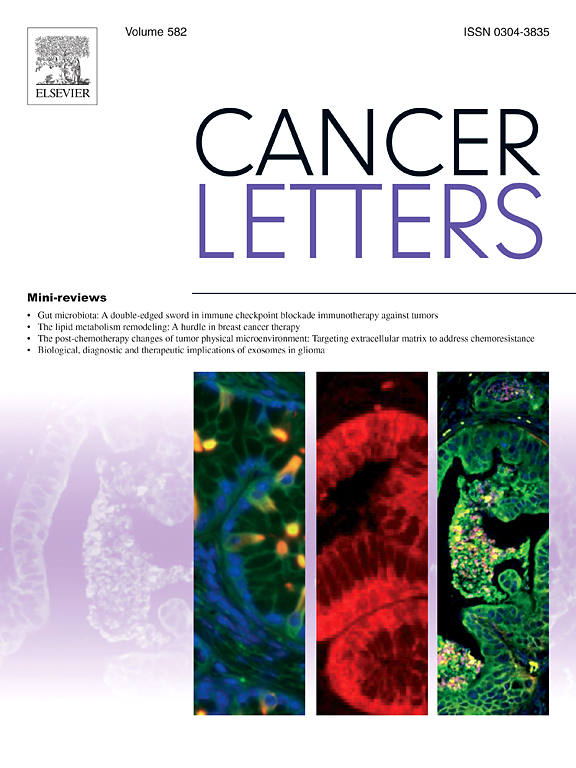Using a novel panel of drug-resistant triple-negative breast cancer cell lines to identify candidate therapeutic targets and biomarkers
IF 9.1
1区 医学
Q1 ONCOLOGY
引用次数: 0
Abstract
Here, we introduce a novel set of triple-negative breast cancer (TNBC) cell lines consisting of MDA-MB-468, HCC38, and HCC1806 and their sublines adapted to cisplatin, doxorubicin, eribulin, paclitaxel, gemcitabine, or 5-fluorouracil. Whole exome sequencing combined with TCGA-derived patient data resulted in the identification of 682 biomarker candidates in a pan-cancer analysis. Thirty-five genes were considered the most promising candidates because they harbored resistance-associated variants in at least two resistant sublines, and their expression correlated with TNBC patient survival. Exome sequencing and response profiles to cytotoxic drugs and DNA damage response inhibitors identified revealed remarkably little overlap between the resistant sublines, suggesting that each resistance formation process follows a unique route. This reflects recent findings on cancer cell evolution in patients, supporting the relevance of drug-adapted cancer cell lines as preclinical models of acquired resistance. Moreover, all of the drug-resistant TNBC sublines remained sensitive or even displayed collateral sensitivity to a range of tested compounds. Cross-resistance levels were lowest for the CHK2 inhibitor CCT241533, the PLK1 inhibitor SBE13, and the RAD51 recombinase inhibitor B02, suggesting that CHK2, PLK1, and RAD51 are potential drug targets for therapy-refractory TNBC. In conclusion, we present novel preclinical models of acquired drug resistance in TNBC and the identification of novel candidate therapeutic targets and biomarkers for this disease.
使用一组新的耐药三阴性乳腺癌细胞系来确定候选治疗靶点和生物标志物
在这里,我们介绍了一组新的三阴性乳腺癌(TNBC)细胞系,由MDA-MB-468、HCC38和HCC1806组成,以及它们适应顺铂、阿霉素、艾瑞布林、紫杉醇、吉西他滨或5-氟尿嘧啶的亚系。全外显子组测序结合tcga衍生的患者数据,在泛癌症分析中鉴定出682个生物标志物候选物。35个基因被认为是最有希望的候选者,因为它们在至少两个耐药亚群中含有耐药相关的变异,并且它们的表达与TNBC患者的生存相关。外显子组测序和对细胞毒性药物和DNA损伤反应抑制剂的反应谱显示,耐药亚系之间的重叠非常少,表明每种耐药形成过程遵循独特的途径。这反映了最近关于患者癌细胞进化的发现,支持药物适应癌细胞系作为获得性耐药的临床前模型的相关性。此外,所有耐药TNBC亚系对一系列测试化合物保持敏感,甚至表现出附带敏感性。CHK2抑制剂CCT241533、PLK1抑制剂SBE13和RAD51重组酶抑制剂B02的交叉耐药水平最低,这表明CHK2、PLK1和RAD51是治疗难治性TNBC的潜在药物靶点。总之,我们提出了TNBC获得性耐药的新的临床前模型,并确定了这种疾病的新的候选治疗靶点和生物标志物。
本文章由计算机程序翻译,如有差异,请以英文原文为准。
求助全文
约1分钟内获得全文
求助全文
来源期刊

Cancer letters
医学-肿瘤学
CiteScore
17.70
自引率
2.10%
发文量
427
审稿时长
15 days
期刊介绍:
Cancer Letters is a reputable international journal that serves as a platform for significant and original contributions in cancer research. The journal welcomes both full-length articles and Mini Reviews in the wide-ranging field of basic and translational oncology. Furthermore, it frequently presents Special Issues that shed light on current and topical areas in cancer research.
Cancer Letters is highly interested in various fundamental aspects that can cater to a diverse readership. These areas include the molecular genetics and cell biology of cancer, radiation biology, molecular pathology, hormones and cancer, viral oncology, metastasis, and chemoprevention. The journal actively focuses on experimental therapeutics, particularly the advancement of targeted therapies for personalized cancer medicine, such as metronomic chemotherapy.
By publishing groundbreaking research and promoting advancements in cancer treatments, Cancer Letters aims to actively contribute to the fight against cancer and the improvement of patient outcomes.
 求助内容:
求助内容: 应助结果提醒方式:
应助结果提醒方式:


